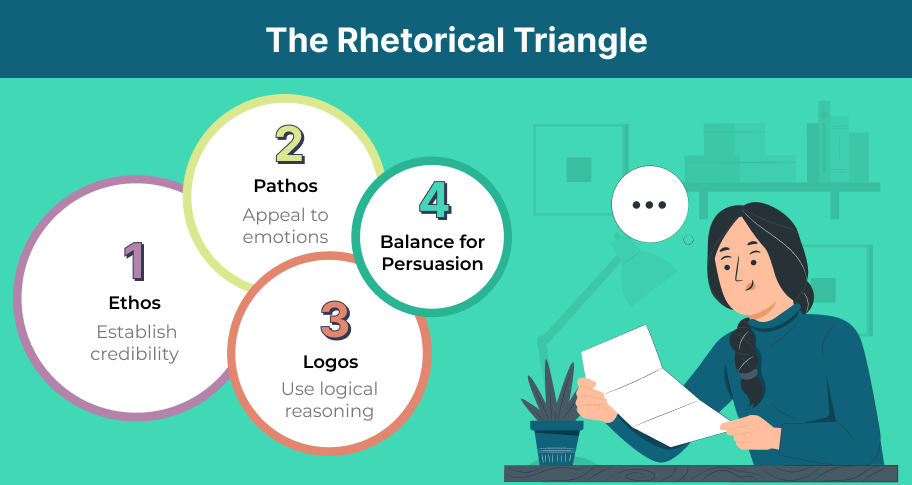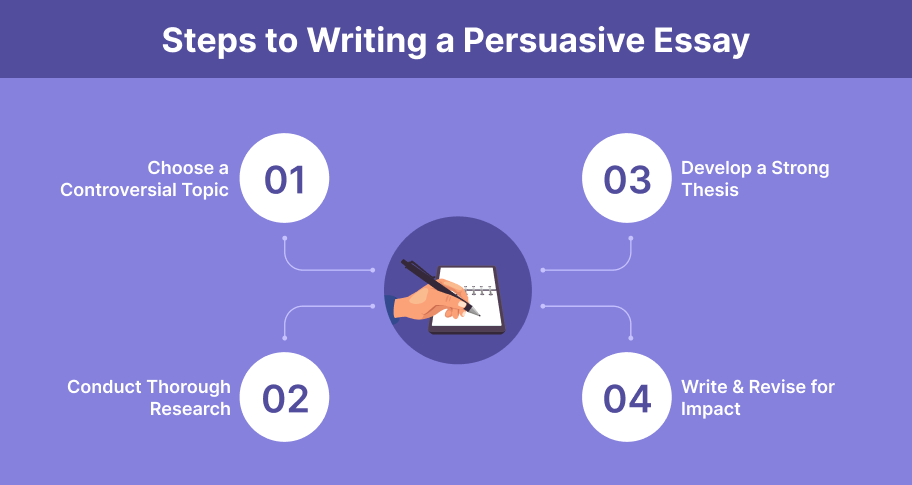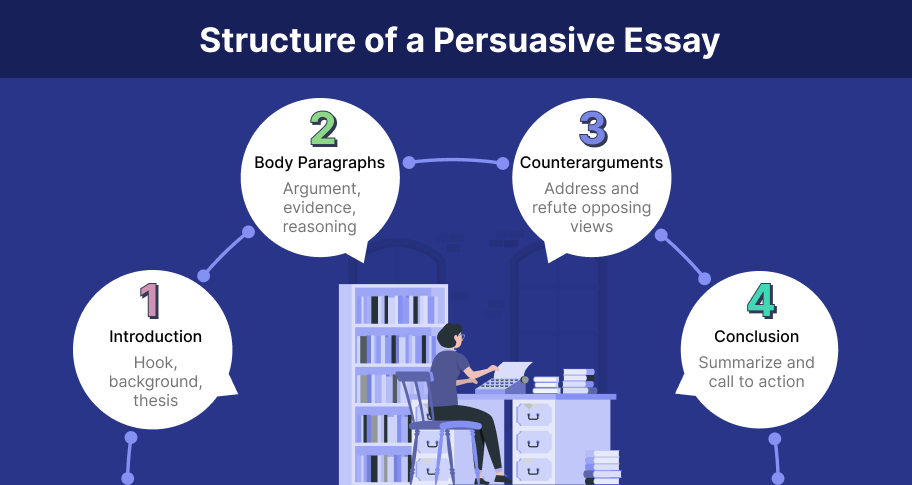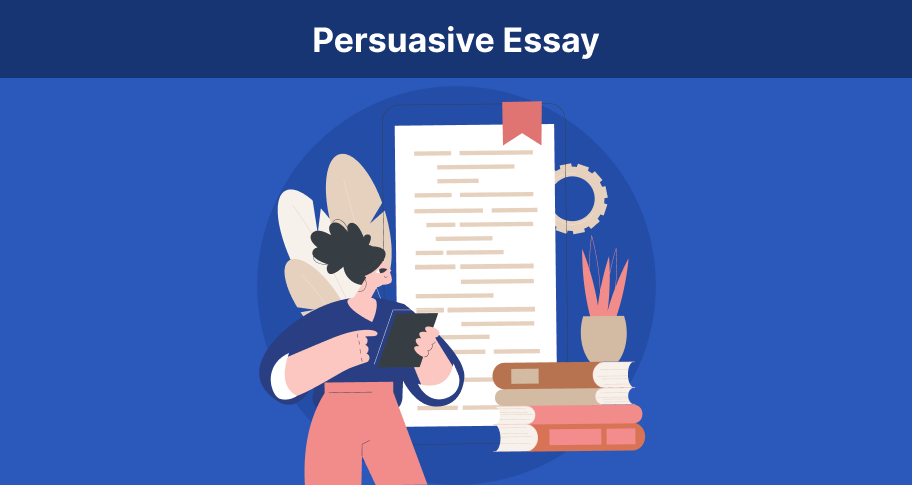Introduction
Imagine a world where words can change minds. A world where the way you express yourself triggers a shift in perspectives. A world where you can influence action with a few, simple, articulate, thoughtful lines. Consider Reagan’s 1987 “Mr. Gorbachev, tear down this wall!” speech, which catalyzed the ending of the Cold War and the fall of the Soviet Union. This is the power of persuasion—and it’s a skill that you can master.
What is a Persuasive Essay?
A persuasive essay is a piece of writing that has as its purpose the goal of convincing the reader to adopt a specific viewpoint or take a particular action. It is writing that combines factual evidence with rhetorical appeals to create a compelling argument.
Importance of Persuasive Writing
Whether you’re in high school, college, the workplace, or even at home, you’re going to benefit from having the ability to persuade. Persuasive writing teaches you how to use arguments to get your point across effectively. It is a style of essay writing that helps you learn how to impact others, how to present your ideas, and how to achieve your goal of getting others to buy into your viewpoint.
Article Overview
This article will guide you through the most important components of a persuasive essay. We’ll look at everything from the fundamentals of persuasion to the benefits of revising your final draft for maximum impact.
Understanding the Fundamentals of Persuasion
The Rhetorical Triangle: Ethos, Pathos, Logos
- Ethos: Ethos is the credibility or trustworthiness of the writer. You can establish ethos in your persuasive essay by showing your expertise on the topic. Do this by citing reliable sources, maintaining composure and an authoritative but fair and balanced tone.
- Pathos: Facts aren’t the only way to reach a reader; feelings help, too. Pathos appeals to the reader’s emotions. Underneath every emotion is a belief about right and wrong. By using emotional appeal, you can tap that belief. This anchors your argument right to the heart of the reader. In this way, pathos lets you connect with your audience on a personal level. Techniques for pathos include storytelling, using vivid language, and telling anecdotes.
- Logos: Logos involves the use of logic and reasoning. To create a solid persuasive argument, you have to give facts. Present some statistics, and use logical reasoning to show that there is support for your thesis.

Key Elements of Persuasive Writing
- Clear and Concise Language: Using simple and direct language is number one. Ambiguous language only adds to confusion. Precise wording lets your message be understood. Don’t use jargon or overly complex sentences that might make your point harder to understand.
- Strong Arguments: A persuasive essay is built on well-reasoned arguments supported by evidence. Make sure each argument is relevant to your thesis and is backed by credible sources.
- Counterarguments and Refutations: Addressing opposing viewpoints shows that you have considered other perspectives and are prepared to answer them. Refuting the opposition helps to strengthen your credibility. If you can anticipate objections and deliver counterarguments, you’re more likely to show that your position is the most valid.
- Call to Action: A call to action urges the reader to take specific steps in response to your essay. It’s an important piece because it encourages the reader to act rather than to be a mere passive recipient of information.
Steps to Writing a Persuasive Essay
1. Choose a Controversial Topic
You don’t want to pick a topic that everyone already agrees on. Instead, go for the polarizing topic: something like why Trump rather than Kamala, or why vaccines are dangerous. If there are multiple perspectives on a subject, it’s probably perfect for a persuasive essay. Persuasive essay topics can range from social or political issues like gun control, abortion, or the war in Ukraine, to more localized topics like school policies like uniforms or teaching critical race theory. Choose a topic that you can feel strongly about and on which there is a lot of research that you can use.
2. Conduct Thorough Research
Research matters. Gather credible evidence from various sources to support your arguments. This includes academic journals, books, reputable websites, and expert opinions. Evaluating the reliability of your sources is key to building a convincing argument.
3. Develop a Clear Thesis Statement
A thesis statement is the central argument of your essay. It should be specific, debatable, and reflect the stance you’ll defend throughout the essay. For example, “The government should defund itself and de-regulate to grow the economy and reduce red tape” is a strong persuasive essay thesis statement.
4. Create a Well-Structured Outline
How do you structure a persuasive essay? First, organization is necessary in persuasive writing. The first step, then, is to outline your essay. A typical persuasive essay outline includes:
- Introduction: Present the topic and your thesis statement.
- Body Paragraphs: Each paragraph focuses on a specific argument supported by evidence.
- Counterarguments and Refutations: Address and refute opposing viewpoints.
- Conclusion: Summarize the main points and restate your thesis with a compelling call to action.
5. Write the Essay
- Introduction: Begin with an engaging introduction that provides background information on your topic and presents your thesis statement.
- Body Paragraphs: Each paragraph should focus on a single persuasive argument. Use evidence and support to back up your claims and logical reasoning to connect your points.
- Counterarguments and Refutations: Respectfully acknowledge opposing viewpoints and refute them with evidence and logic.
- Conclusion: Summarize your arguments and restate your thesis in a way that reinforces your position. End with a strong call to action that encourages the reader to adopt your viewpoint or take specific action.
6. Revise and Edit
Revising and editing are big steps and mustn’t be left out. This is where you bring out the diamond in the rough. Polish up ideas, and make the writing crisp and concise. Revisions should be deliberate, sure, and purposeful. Edit for precision. Proofread for grammar and punctuation errors, and look for feedback from others to get a sense of how well your arguments come off and where they could use some more work.

Persuasive Essay Topics
Current Topics
- Climate change and environmental responsibility
- The impact of social media on mental health
- The ethics of artificial intelligence
- The future of work and automation
- The importance of access to quality education
- Healthcare reform and accessibility
- Gun control and violence prevention
- Immigration and border control policies
- The role of technology in modern society
- Should Schools Enforce Uniform Policies to Promote Equality?
Technology and Society
- Should social media companies be held responsible for the spread of misinformation?
- Are we becoming too reliant on technology?
- Is artificial intelligence a threat or an opportunity for humanity?
- Should there be stricter regulations on data privacy and collection?
- Is the metaverse the future of social interaction?
- Should Governments Implement Stricter Regulations on Cryptocurrencies?
- Should Tech Companies Be More Transparent About How They Use Personal Data?
- Should Companies Make Remote Work Permanent Post-Pandemic?
- Is It Necessary to Implement Stricter Controls to Prevent Misinformation?
Health and Wellness
- Should the COVID-19 vaccine be mandatory for everyone?
- Is the mental health crisis being adequately addressed?
- Should there be stricter regulations on the food and beverage industry to combat obesity?
- Is universal healthcare a right or a privilege?
- The impact of climate change on public health
- Should Genetic Modification in Humans Be Allowed?
Social and Political Issues
- Should the voting age be lowered to 16?
- Is cancel culture beneficial or harmful to society?
- Should the electoral college be abolished?
- Is the current criminal justice system fair and effective?
- The impact of income inequality on social mobility
Education
- Should college education be free for everyone?
- Is standardized testing an accurate measure of student learning?
- The role of technology in the future of education
- The importance of early childhood education
- Should students be required to learn a second language?
- Should Schools Embrace AI Tools for Learning and Teaching?
Environment
- Is renewable energy the solution to climate change?
- Should plastic be banned?
- The impact of fast fashion on the environment
- The importance of conservation and protecting biodiversity
- Is nuclear energy a viable alternative to fossil fuels?
if none of these topics float your boat, check out our other persuasive essay topics recommendation
Persuasive Essay Example
Why Banning Social Media Platforms Harms Society
Introduction
In recent years, governments in countries like Brazil, the UK, and elsewhere have considered or have already taken steps to crack down on social media platforms in an attempt to control misinformation, hate speech, and other harmful content. While the intention may be to protect the public from hate and misinformation, such bans pose serious threats to the right to free speech. Bans set a dangerous precedent for censorship, silencing dissent, and establishing an Orwellian Big Brother type of dictatorship. This essay will argue that banning social media platforms is harmful to a free society and counterproductive to the aims of democratic government.
Body Paragraphs
Use of Ethos
Today, governments are claiming they have a responsibility to maintain public order and safety, by any means necessary. However, their credibility is undermined when they resort to blanket bans on platforms that millions rely on for communication and news. The right to free speech is embedded in the constitution of most democratic societies, and restricting access to social media raises serious ethical and constitutional concerns. For example, in Brazil, the current ban of X has sparked outrage, with many condemning the move as an overreach of power. Banning platforms is an infringement on the right to free speech. It also sets a precedent for governments restricting access to information arbitrarily, which erodes their own commitment to democratic values.
Use of Pathos
For many marginalized people, platforms like X and Facebook are a space to voice their concerns. By banning these platforms, governments risk silencing those who have already been marginalized in mainstream media. For example, people in England are being arrested for voicing their dislike of rampant immigration. These people, often lacking representation in traditional media, rely on social platforms to raise awareness and mobilize support. Cutting off these avenues of communication deprives them of a voice. The government so much as says, “Your voice is not welcome. Off with your head!”
Use of Logos
Logically speaking, banning social media platforms is an ineffective solution to the problem of misinformation. While it may temporarily halt the spread of misinformation or hate speech on one platform, users can easily migrate to other, less regulated platforms, where harmful behavior may proliferate unchecked. Moreover, banning platforms does not address the underlying issues of misinformation, such as lack of media literacy or critical thinking. According to the evidence from multiple studies, educational initiatives aimed at teaching users how to critically evaluate information are far more effective in combating misinformation than outright bans.
Counterarguments and Refutations
Opponents of free speech on social media may argue that banning platforms is a necessary step to curb online extremism and protect vulnerable populations. They might claim that when platforms fail to regulate themselves, government intervention is the only solution. However, this argument overlooks the problem of suppressing dissent, which is really anathema to democratic free societies. Plus, there are numerous successful regulatory frameworks, like in Germany, where the Network Enforcement Act requires platforms to remove illegal content within a specific timeframe or face fines. This approach can be used to balance the need to control harmful content with the need to protect the right to free speech.
Conclusion
In conclusion, banning social media platforms like X in an attempt to control and restrict speech is truly detrimental to society. It undermines the democratic value of free expression and silences those who have a right to voice themselves. It is a short-term solution that caters to censorship instead of education. Governments and platforms should instead work together to help provide education to people when there is concern about misinformation taking hold. In a free society, education and discussion are the best options.

Analysis of Persuasive Techniques
Ethos: The essay uses ethos by questioning the ethical authority of governments that impose social media bans. It is able to cite real-world examples such as Brazil’s X ban and UK’s arrest of social media users. It presents the argument that governments are undermining democratic values when they restrict access to social platforms.
Pathos: Pathos is used effectively in this essay by appealing to the emotions of readers who sympathize with marginalized groups. The loss of a community’s voice shows the emotional harm caused by banning platforms. The essay evokes empathy for those who lose their ability to advocate for themselves in the public space.
Logos: The use of logos is particularly strong in the analysis of the ineffectiveness of social media bans. It gives logical examples—such as users migrating to other platforms and the effectiveness of education. Likewise, the reliance on evidence strengthens the logical appeal of the argument, which helps readers to conclude that censorship is not the most effective way to address the issue of misinformation.
Other Persuasive Techniques: The essay employs repetition by consistently emphasizing the importance of free speech and the consequences of censorship. Additionally, rhetorical questions invite readers to engage emotionally and critically with the issue. This gets them to question their assumptions about government intervention in free speech areas. The essay also uses strong verbs and vivid language to improve its persuasive power.
View 120,000+ High Quality Essay Examples
Learn-by-example to improve your academic writing
Tips for Writing an Effective Persuasive Essay
- Know Your Audience and Tailor Your Arguments Accordingly: Understanding your audience is a necessary part of persuasive writing. To be convincing, you must know who you are speaking to—whether they are neutral, already in agreement, or opposed to your stance. Customize your arguments to appeal to their values or to their level of knowledge on the topic. For example, if you’re writing for a scientific community, focus on logical reasoning and data. If your audience is more emotionally driven, use personal stories or real-life examples.
- Use Vivid Language and Imagery to Engage the Reader’s Emotions: Pathos is a powerful tool in persuasion. Vivid language, sensory details, imagery, and good stories all help your readers visualize your points and feel connected to your argument. For example, rather than simply stating facts about poverty, describe what being poor is actually like for people in different parts of the world. This type of emotional engagement can make your essay a real success.
- Appeal to the Reader’s Sense of Logic and Reason: While emotional appeal is important, logical reasoning is always going to be the backbone of any effective persuasive essay. Use facts and good arguments to back up your claims. Present your evidence in a structured way that helps the reader arrive at the obvious conclusion.
- Establish Your Credibility Through Research and Tone: Ethos is instrumental in gaining the confidence of your audience. Cite reputable sources and present balanced arguments. Be fair and just—this will go a long way towards earning the reader’s respect. Maintain a professional and considerate tone. Avoid biased language or unsubstantiated claims, as they can erode your authority.
- Anticipate and Address Counterarguments: A well-rounded persuasive essay doesn’t shy away from opposing viewpoints. In fact, acknowledging and refuting counterarguments strengthens your position by showing that you’ve considered multiple sides of the issue. When addressing opposing views, do so respectfully, and use evidence and logical reasoning to dismantle them.
- End with a Memorable and Impactful Conclusion: Your conclusion is the last chance to leave a lasting impression on the reader. Summarize your main points, reinforce your thesis, and end with a strong call to action or something that will stimulate further thought. An impactful conclusion motivates the reader to think, change a perspective, or take action.

Common Mistakes to Avoid
- Overusing Emotional Appeals: While pathos is important, you don’t want to rely too heavily on emotional appeals, which can weaken your argument. Balance emotion with evidence and logical reasoning.
- Ignoring Counterarguments: Failing to address opposing viewpoints can make your argument appear one-sided. Always consider and refute counterarguments to strengthen your essay.
- Lack of Clear Structure: A disorganized essay just muddies the waters and doesn’t help your argument at all. Stick to a clear and logical structure (and use a well-built persuasive essay outline) so that your argument is easy to follow.
Conclusion
In this article, we’ve looked at the essential elements of persuasive writing, from understanding the power of ethos, pathos, and logos to the importance of structuring a well-argued persuasive essay. We’ve also described the importance of addressing counterarguments and having a call to action. So, whether you’re writing for academic purposes, professional goals, or personal reasons, you’re now in a better position to do so successfully.
Remember, persuasive writing isn’t just an academic skill—it’s a tool for influencing others, shaping public opinion, calling for change, and motivating your community to take up action. When you hone your persuasive skills, yet set yourself up to be effective in debates, proposals, and just all-around everyday interactions with others. Practice is key, so start writing and applying what you’ve learned today.
For those looking to further their skills, there are many excellent resources available. Books like The Elements of Persuasion by Richard Maxwell or Thank You for Arguing by Jay Heinrichs are great starting points. Websites like Purdue OWL offer great tutorials on persuasive writing and how to use rhetoric to your advantage.
Ready to improve your writing? Share this article on social media to help others improve their persuasive skills. If you have any comments or questions, we encourage you to leave them below—we’d love to hear your thoughts!
For students seeking essay examples, teachers looking for classroom resources, or writers wanting more tips, explore our example documents or download our persuasive essay worksheet. Dive into real-world applications and see how persuasive writing can influence change in every aspect of your life.






